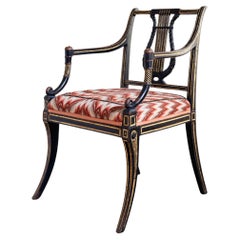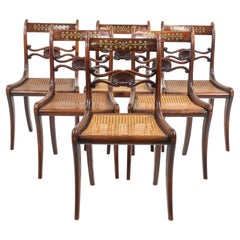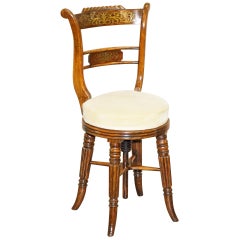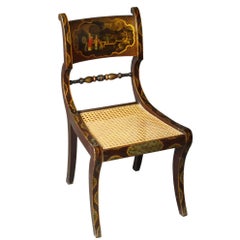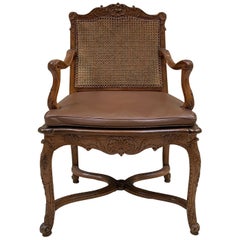Regency Beech Chairs
Antique Early 19th Century British Regency Chairs
Beech
Antique Early 19th Century English Regency Chairs
Brass
Antique Early 19th Century English Regency Side Chairs
Wood, Beech
Antique Early 19th Century English Regency Chairs
Beech
Recent Sales
Antique 19th Century English Regency Chairs
Beech
Antique 18th Century European Regency Chairs
Beech
Antique Early 19th Century British Regency Dining Room Chairs
Beech
Antique 19th Century English Regency Dining Room Chairs
Beech
Antique Early 19th Century British Regency Armchairs
Beech
Antique 1830s English Regency Chairs
Beech, Rosewood
Antique Mid-19th Century English Regency Chairs
Cane, Beech
Antique Early 19th Century English Regency Chairs
Beech
Antique Early 19th Century English Regency Chairs
Beech
Antique 1830s Great Britain (UK) Regency Chairs
Beech, Cane
Antique 18th Century and Earlier French Regency Chairs
Beech
20th Century English Regency Chairs
Beech
Late 20th Century British Regency Armchairs
Leather, Beech
20th Century English Regency Dining Room Chairs
Velvet, Beech
Vintage 1960s European Regency Chairs
Beech
Antique Early 19th Century English Regency Slipper Chairs
Beech
Antique Early 19th Century English Regency Side Chairs
Beech, Paint
Antique Early 19th Century English Regency Armchairs
Rush, Beech
Antique Early 19th Century English Regency Armchairs
Beech
Vintage 1960s French Regency Chairs
Beech
Antique 18th Century Danish Regency Chairs
Cowhide, Beech
20th Century British Regency Chairs
Beech
Antique Early 19th Century English Regency Chairs
Beech
Antique Early 19th Century British Regency Side Chairs
Beech
21st Century and Contemporary Spanish Regency Dining Room Chairs
Upholstery, Beech
Antique 1780s French Regency Armchairs
Tapestry, Cane, Beech
Antique Mid-19th Century English Regency Armchairs
Beech
21st Century and Contemporary British Regency Armchairs
Leather, Beech
Antique 19th Century English Regency Chairs
Beech
Early 2000s Unknown Regency Armchairs
Leather, Beech
Antique Early 19th Century Great Britain (UK) Regency Side Chairs
Beech, Paint
Antique Early 19th Century English Regency Chairs
Beech
Antique Early 19th Century British Regency Side Chairs
Beech
Antique Early 19th Century English Regency Armchairs
Beech
Antique Early 19th Century British Regency Armchairs
Beech, Cane
Antique Early 19th Century British Regency Dining Room Chairs
Beech, Mahogany
Antique 1810s English Regency Chairs
Beech
People Also Browsed
21st Century and Contemporary Vietnamese Modern End Tables
Wood
21st Century and Contemporary Swedish Mid-Century Modern Table Lamps
Textile
21st Century and Contemporary European Modern Side Tables
Travertine, Wrought Iron
2010s Italian Modern Chandeliers and Pendants
Metal, Brass
Antique Late 19th Century Louis Philippe Wall Mirrors
Gesso, Pine, Paint
Antique Early 19th Century French Georgian Farm Tables
Sycamore
2010s Vietnamese Dining Room Chairs
Oak
2010s American Mid-Century Modern Table Lamps
Brass
Vintage 1950s Italian Mid-Century Modern Dining Room Chairs
Fabric, Walnut
Antique Mid-19th Century Tibetan Tibetan Cabinets
Pine
2010s English Folk Art Side Tables
Wrought Iron
2010s Austrian Jugendstil Chandeliers and Pendants
Silk
Vintage 1930s Swedish Art Deco Sofas
Fabric, Wood
Antique Mid-19th Century Swedish Gustavian Commodes and Chests of Drawers
Wood
Antique 1810s Unknown Regency Chairs
Mahogany
Antique 19th Century English Ladders
Mahogany
Regency Beech Chairs For Sale on 1stDibs
How Much are Regency Beech Chairs?
A Close Look at Regency Furniture
Like France’s Empire style, Regency-style furniture was rooted in neoclassicism; the characteristics of its bedroom furniture, armchairs, dining room tables and other items include clean lines, angular shapes and elegant details.
Dating roughly from the 1790s to 1830s, antique Regency-style furniture gets its name from Prince George of Wales — formally King George IV — who became Prince Regent in 1811 after his father, George III, was declared unfit to rule. England’s Regency style is one of the styles represented in Georgian furniture.
George IV’s arts patronage significantly influenced the development of the Regency style, such as the architectural projects under John Nash, which included the renovation of Buckingham House into the formidable Buckingham Palace with a grand neoclassical facade. Celebrated designers of the period include Thomas Sheraton, Henry Holland and Thomas Hope. Like Nash, Hope instilled his work with classical influences, such as saber-legged chairs based on the ancient Greek klismos. He is credited with introducing the term “interior decoration” to English with the 1807 publishing of Household Furniture and Interior Decoration.
Although more subdued than previous styles like Rococo and Baroque, Regency interiors incorporated copious use of chintz fabrics and wallpaper adorned in chinoiserie-style art. Its furniture featured fine materials and luxurious embellishments. Furniture maker George Bullock, for instance, regularly used detailed wood marquetry and metal ornaments on his pieces.
Archaeological discoveries in Egypt and Greece informed Regency-era details, such as carved scrollwork, sphinxes and palmettes, as well as the shape of furniture. A Roman marble cinerary chest, for example, would be reinterpreted into a wooden cabinet. The Napoleonic Wars also inspired furniture, with martial designs like tented beds and camp-style chairs becoming popular. While the reddish-brown mahogany was prominent in this range of pieces, imported woods like zebrawood and ebony were increasingly in demand.
Find a collection of antique Regency tables, seating, decorative objects and other furniture on 1stDibs.
Finding the Right Chairs for You
Chairs are an indispensable component of your home and office. Can you imagine your life without the vintage, new or antique chairs you love?
With the exception of rocking chairs, the majority of the seating in our homes today — Windsor chairs, chaise longues, wingback chairs — originated in either England or France. Art Nouveau chairs, the style of which also originated in those regions, embraced the inherent magnificence of the natural world with decorative flourishes and refined designs that blended both curved and geometric contour lines. While craftsmanship and styles have evolved in the past century, chairs have had a singular significance in our lives, no matter what your favorite chair looks like.
“The chair is the piece of furniture that is closest to human beings,” said Hans Wegner. The revered Danish cabinetmaker and furniture designer was prolific, having designed nearly 500 chairs over the course of his lifetime. His beloved designs include the Wishbone chair, the wingback Papa Bear chair and many more.
Other designers of Scandinavian modernist chairs introduced new dynamics to this staple with sculptural flowing lines, curvaceous shapes and efficient functionality. The Paimio armchair, Swan chair and Panton chair are vintage works of Finnish and Danish seating that left an indelible mark on the history of good furniture design.
“What works good is better than what looks good, because what works good lasts,” said Ray Eames.
Visionary polymaths Ray and Charles Eames experimented with bent plywood and fiberglass with the goal of producing affordable furniture for a mass market. Like other celebrated mid-century modern furniture designers of elegant low-profile furnishings — among them Ludwig Mies van der Rohe and Finn Juhl — the Eameses considered ergonomic support, durability and cost, all of which should be top of mind when shopping for the perfect chair. The mid-century years yielded many popular chairs.
The Eameses introduced numerous icons for manufacturer Herman Miller, such as the Eames lounge chair and ottoman, molded plywood dining chairs the DCM and DCW (which can be artfully mismatched around your dining table) and a wealth of other treasured pieces for the home and office.
A good chair anchors us to a place and can become an object of timeless appeal. Take a seat and browse the rich variety of vintage, new and antique chairs on 1stDibs today.
